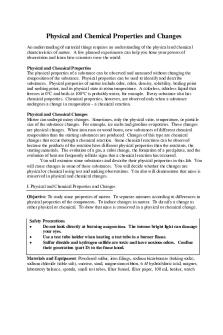Experiment Testing The Strength And Physical Properties Of Nylon Report PDF

| Title | Experiment Testing The Strength And Physical Properties Of Nylon Report |
|---|---|
| Course | Organic Chemistry 3 |
| Institution | University of Chicago |
| Pages | 2 |
| File Size | 111.9 KB |
| File Type | |
| Total Downloads | 79 |
| Total Views | 145 |
Summary
Synthesis of Nylon Lab Report...
Description
Synthesis of Nylon Lab Report Purpose: The purpose of this experiment is to synthesize Nylon 6,10 from Sebacoyl Chloride and 1,6-Hexanediamine and to determine the tensile strength and physical properties of the Nylon product.
Results: 1. Percent Yield of Nylon We used 20 mL of 0.2 M Sebacoyl Chloride/Hexane Solution with 20 mL of 0.5 M 1,6-Hexanediamine/NaOH (aq) Solution. Clearly, the limiting reagent is Sebacoyl Chloride, as there is a 1:1 molar stoichiometry between the reagents. 20 mL Sebacoyl Chloride x (0.2 mol Sebacoyl Chloride / 1 L) = 0.004 mol Sebacoyl Chloride Used 0.004 mol Sebacoyl Chloride x (1 mol Nylon 6,10 / 1 mol Sebacoyl Chloride) = 0.004 mol Nylon 6,10 Expected 0.004 mol Nylon 6,10 x (282.43 g / 1 mol Nylon 6,10) = 1.13 g Theoretical Yield We obtained 5.31 g of Nylon, therefore our yield was (5.31 g / 1.13 g) * 100 = 470% Yield. ERROR ANALYSIS: Given this very high yield, there needs to be discussion of potential sources of such a high yield or "error." The nylon we had synthesized was very wet, to the point that it was almost pasty when it first was rolled from the reaction beaker. Even after drying, the nylon was likely quite wet and, given the high density of water, this likely explains our yield being so high. 2. Nylon Appearance and Tensile Strength Our final product after drying for 15 minutes was a white fabric-like, product. The product had relatively strong tensile strength, however, it tore with high stretching force. When torn, this product appeared to have bristle-like ends. This makes sense, as Nylon 6,10 is typically used in bristles and brushes1 .
Discussion: 1. There were two purposes of the NaOH in the solution with 1,6-Hexanediamine. The first purpose of having the NaOH-- as seen in the mechanism of the reaction-- is to establish basic conditions for the deprotonation of the amine group, which is needed for the formation of an amide from an acid chloride and an amine. The second purpose of the NaOH is to neutralize the HCl formed as a side product. If we don't neutralize the HCl, there could be side reactions with the Nylon or the Nylon product could be damaged. 2. If we had used Sebacic Acid instead of Sebacoyl Chloride, the reaction would require much more heat, as this is a dehydration reaction rather than a nucleophilic acyl substitution reaction. The reason that heat is needed when using Sebacic Acid is because the reaction proceeds with an ammonium carboxylate salt intermediate, which requires high temperatures to remove an H2O group to form an amide.
Structure of Sebacic Acid
Works Cited: 1. Scott, C. (n.d.). Nylon-6,10. Retrieved from http://www.polymerprocessing.com/polymers/PA610.html...
Similar Free PDFs

physical properties lab report
- 10 Pages

physical properties of food quiz
- 1 Pages

Physical properties table
- 32 Pages
Popular Institutions
- Tinajero National High School - Annex
- Politeknik Caltex Riau
- Yokohama City University
- SGT University
- University of Al-Qadisiyah
- Divine Word College of Vigan
- Techniek College Rotterdam
- Universidade de Santiago
- Universiti Teknologi MARA Cawangan Johor Kampus Pasir Gudang
- Poltekkes Kemenkes Yogyakarta
- Baguio City National High School
- Colegio san marcos
- preparatoria uno
- Centro de Bachillerato Tecnológico Industrial y de Servicios No. 107
- Dalian Maritime University
- Quang Trung Secondary School
- Colegio Tecnológico en Informática
- Corporación Regional de Educación Superior
- Grupo CEDVA
- Dar Al Uloom University
- Centro de Estudios Preuniversitarios de la Universidad Nacional de Ingeniería
- 上智大学
- Aakash International School, Nuna Majara
- San Felipe Neri Catholic School
- Kang Chiao International School - New Taipei City
- Misamis Occidental National High School
- Institución Educativa Escuela Normal Juan Ladrilleros
- Kolehiyo ng Pantukan
- Batanes State College
- Instituto Continental
- Sekolah Menengah Kejuruan Kesehatan Kaltara (Tarakan)
- Colegio de La Inmaculada Concepcion - Cebu












